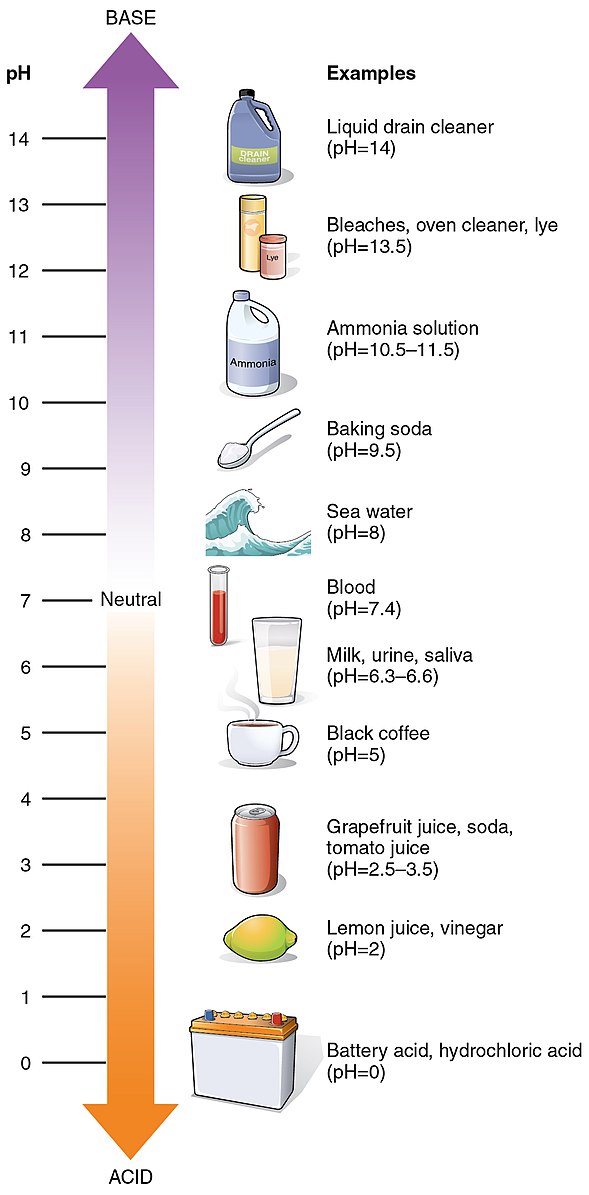The pH of coffee and soda are quite different, with coffee being generally less acidic than soda. While coffee typically has a pH range of 4.85 to 5.70, soda can have a pH as low as 2.00, with some colas having a pH of around 2.34. Understanding the acidity levels of these popular beverages is crucial for maintaining dental health and making informed choices.
The pH Scale: Measuring Acidity
The pH scale ranges from 0 to 14, with 7 being neutral. Values below 7 are considered acidic, while values above 7 are basic or alkaline. The lower the pH value, the more acidic the substance is.
Coffee: The Mildly Acidic Beverage
 Image source: OpenStax College
Image source: OpenStax College
Coffee, a beloved morning drink, generally falls within the mildly acidic range on the pH scale. The pH of coffee can vary depending on factors such as the type of coffee beans, the roasting process, and the brewing method. Typically, a cup of coffee has a pH between 4.85 and 5.70.
The Acidity of Coffee and Dental Health
While coffee is less acidic than soda, it can still contribute to dental erosion and staining. The acidity in coffee can dissolve the enamel and dentin of teeth, leading to increased sensitivity and a higher risk of cavities. However, the impact of coffee on dental health is generally less severe than that of soda.
Soda: The Highly Acidic Culprit
Soda, on the other hand, is known for its high acidity levels. The pH of soda can be as low as 2.00, with some colas having a pH of around 2.34. This level of acidity is significantly lower than that of coffee and can have a more detrimental effect on dental health.
The Erosive Power of Soda
The high acidity of soda can lead to dental erosion, a process where the enamel and dentin of teeth are dissolved. This can result in increased sensitivity, the formation of cavities, and even the exposure of the underlying tooth structure.
Balancing the Acidity: Moderation and Oral Hygiene
To maintain dental health and minimize the negative effects of coffee and soda, it is essential to consume these beverages in moderation and practice good oral hygiene.
Moderation is Key
Consuming coffee and soda in moderation can help reduce the exposure of teeth to the acidic environment. It is recommended to limit the consumption of these beverages and to rinse the mouth with water after drinking to help neutralize the acid.
Oral Hygiene Practices
Maintaining good oral hygiene, such as regular brushing, flossing, and using a fluoride-containing toothpaste, can help protect teeth from the damaging effects of the acidity in coffee and soda. Additionally, using a water filter to remove contaminants from drinking water can help reduce exposure to chemicals that may be present in these beverages.
Mitigating the Acidity: Additives and Alternatives
There are several ways to mitigate the acidity of coffee and soda, including the use of additives and exploring alternative beverages.
Additives for Coffee
Adding milk to coffee can help reduce its acidity and provide a more neutral pH. The calcium in milk can help neutralize the acid, protecting the enamel of teeth.
Alternatives to Soda
Choosing alternative beverages, such as water, unsweetened tea, or milk, can help reduce the exposure to the high acidity and other harmful components found in soda.
Conclusion
In conclusion, the pH of coffee and soda are quite different, with coffee being generally less acidic than soda. Understanding the acidity levels of these popular beverages is crucial for maintaining dental health and making informed choices. By consuming these beverages in moderation, practicing good oral hygiene, and exploring alternative options, individuals can enjoy their favorite drinks while minimizing the negative impact on their teeth and overall oral health.
References:
– Quora.com, “If the pH of a cola drink is 3 and of black coffee is 5, how many times…”
– Mark Danner, DMD. “Table of Beverage Acidity”
– ResearchGate.net, “pH of energy drinks and teas and coffee”
– GoAskAlice.columbia.edu, “Pop versus coffee”
– NewAlbanySmiles.com, “pH values of Common Beverages”
– NCBI.nlm.nih.gov, “The pH of beverages available to the American consumer”
